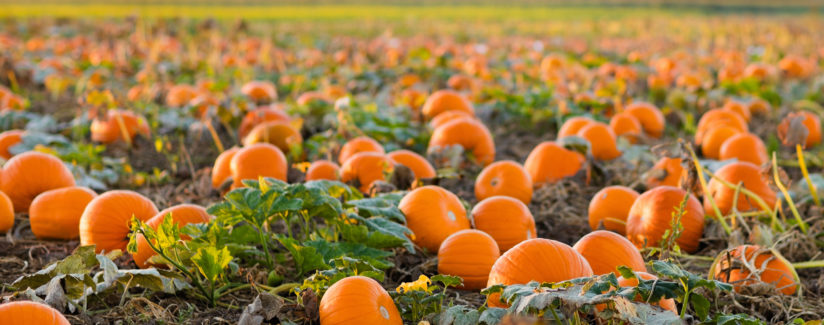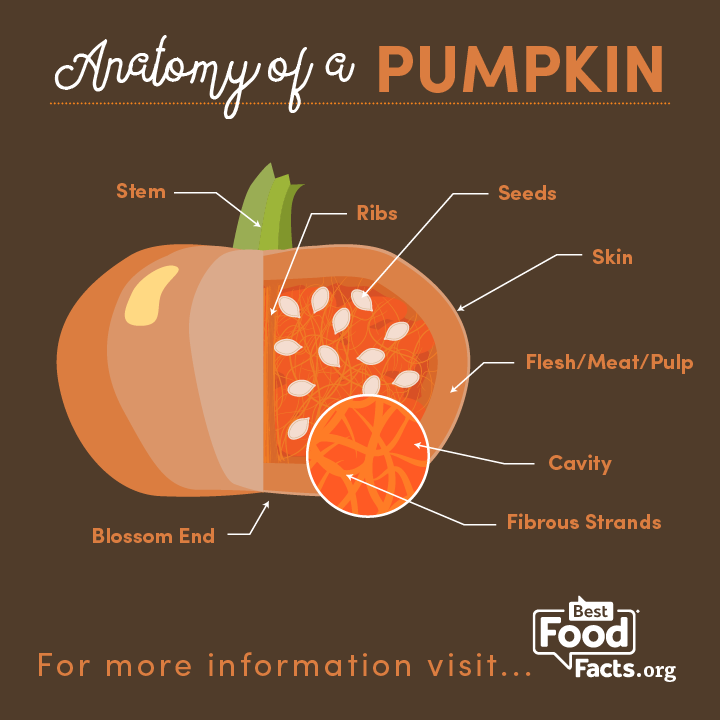
Food Facts: 8 Things to Know About Pumpkins
It’s always exciting to see a big fat bright orange pumpkin. Whether growing in a field, displayed in a store or getting diced up for a pie, there are many ways to enjoy pumpkins.
We put together a list of eight things to know about pumpkins so that the next time pumpkins pop up into your conversations (or view), you can share some fun #pumpkinknowledge.
- Pumpkins are originally from Central America and Mexico.
When you walk around a Mexican market the pumpkins don’t resemble the “traditional” ones. Most pumpkins are some variation of bulbous, beige, round, green-stripped, bumpy, yellow and have crooked necks. The classic pumpkins widely used as jack-o-lanterns are the Connecticut Field Pumpkin because of where this specific type was discovered, aka in Connecticut. - The Pumpkin Capital is in Illinois.
Today pumpkins grow in six continents in various different shapes, colors and forms. Unfortunately, you can’t grow pumpkins in Antarctica. In the U.S., Illinois grows more than 90 percent of all pumpkins and Morton, Ill., is the self-proclaimed Pumpkin Capital of the World. More than 5 million acres of pumpkins were harvested in the U.S. in 2014. - Pumpkins have a spooky past.
Carving pumpkins originally started in Ireland, as part a Celtic tradition on All Hallow’s Eve. People would carve turnips and rutabagas to help ward-off evil spirits like Stingy Jack. Irish immigrants in America discovered pumpkins were a much better substitute and that’s why we still carve pumpkins for JACK-o-Lanterns for Halloween today. - Pumpkins take the lead in two holidays.
Pumpkins may or may not have been part of the Thanksgiving meal between the Pilgrims and Native Americans. Pumpkins were widely used by Native Americans and Native Americans would flatten strips of pumpkins, then dry and make mats out of them. They also used pumpkin seeds as food and medicine. By the late 1700s pumpkin pie recipes were commonly used by the Pilgrims. - They’re good for you.
Food and Nutrition Specialist Julie Garden-Robinson explains just how nutritious pumpkins are. “Pumpkins are packed with nutrients, especially beta-carotene and fiber. Our bodies use beta-carotene to produce vitamin A. In fact, half a cup of pumpkin provides 200 percent of the current recommendation for vitamin A, along with lutein and zeaxanthin, which are pigments that promote eye health. Pumpkins are rich in potassium, which helps our muscles contract and nerves fire. While pumpkin is low in calories. One-half cup of mashed pumpkin (without salt) has 24 calories, 0 grams (g) fat, 1 g protein, 6 g carbohydrate, 1 g fiber and 1 milligram sodium.” - Even pumpkin seeds prove very nutritious.
Two tablespoons of unshelled and roasted pumpkin seeds are only 125 calories and contains 15 grams of carbohydrates, five grams of protein, five percent of your daily iron needs. The same amount of shelled and roasted seeds are only 163 calories and are more nutrient dense with four grams of carbohydrates, eight grams of protein and eight percent of your daily iron needs. Pumpkin seeds are also a great source to add additional magnesium, copper, selenium and zinc to your diet. - Not only can you use and eat most of a pumpkin, but you can also eat the pumpkin flower.
The pumpkin flowers are great at treating the common cold (vitamin C), boosting male infertility (vitamin B9), ensuring eye health (vitamin A), and bone formation (phosphorus).
- You can eat – and drink – pumpkin many ways.
You can make pumpkin soup or hummus, turn pumpkin puree into some type of pasta sauce, a yummy chili or even make lasagna! Some people sweeten pumpkin with honey and toss it in their yogurt, others use pumpkin substitute as part of the fat in baked goods (think something like brownies). Pumpkin spice latte is a favorite, but you can make other drinks like a pumpkin cocktail or beer. Roasting the pumpkins seeds in salt and pepper, chili powder or cinnamon is a slightly healthier option as well! But some of the top recipes center around a muffin, cake, or a roll filled or glazed with some sort of cream cheese. Pancakes and scones are always a yummy addition to the pumpkin recipe list when trying to incorporate pumpkin into every meal of the day.
Now you are fully versed in #pumpkinknowledge and can proudly show off with friends when carving your Jack-O-Lanterns or when baking a pumpkin pie. Check out our Pinterest board for pumpkin-themed decorations and recipes.


























